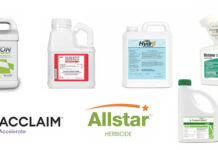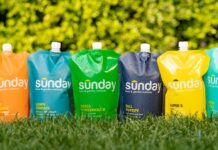Just taken over a new lawn and landscape? You’re bound to be struggling with weeds with new accounts — grassy weeds, broadleaf weeds, weird-looking weeds, all sorts of weeds.
In many cases, the client has taken their sweet time hiring a new company, or has failed by using ineffective methods or products to control weeds. If I had a nickel for every time one of my clients complained that they were not getting control of grassy weeds with a “weed and feed” product, I’d be a rich man. Well, not rich, but I’d certainly have enough for a nice vacation. The good news is that there are simple, straightforward methods you can use to get rid of them.

A thick, dense lawn
Let’s start with the most obvious and most important. The best weed control is a thick, dense lawn. A thick lawn shades the soil surface, discouraging the germination of lawn weeds. The ones that make it through have to fight robust grass plants for nutrients and water.
So, do whatever you can to keep an existing lawn healthy — fertilize, water regularly, aerate to alleviate compaction and control pests. If the lawn is thin, overseed to introduce more grass plants.
That said, you might have customers that are a bit squeamish about the application of herbicides to control weeds. This reluctance usually leads to inactivity, which leads to loads of weeds to be dealt with.
Fortunately, other options exist that can be used in conjunction with herbicides. A two-step approach is most effective: combining chemical applications with sound cultural practices, and then communicating your actions, both chemical and cultural, to your clients.
Why timing matters
In the 1990 film, “Goodfellas,” Ray Liota, aka Henry Hill, took his girlfriend to a nightclub to impress her. The featured performer was an old vaudevillian named Henny Youngman. Henny knew the importance of timing. His signature line was “Take my wife … please.” Sorta funny, but what’s most instructive is that he delivered the line with perfect timing. If he had said, “Take my wife please,” it’s not funny at all.
The same is true for weed control. Dandelions and other broadleaf weeds are best controlled in the fall, while crabgrass and related annual grassy weeds should generally be targeted in late spring.
Why fall for broadleaves? Four good reasons:
1. Effectiveness. If the target weed doesn’t die outright from the application, it is likely to be stressed and enter winter in a weakened state, during which it will have a greater chance of dying.
2. The phenomenon of “facilitated transport” is on your side. In fall, weeds are in the gradual process of translocating sugars and carbohydrates from the leaves to the roots for the winter. Fall applications are more likely to be moved into the crown and roots than at other times of the year.
3. Cuticle. In summer, many broadleaf weeds produce a thick cuticle, an adaptation to limit moisture loss during periods of heat and drought. In fall, the newly produced leaves grow a thinner cuticle, which increases the chances of absorption rather than runoff.
4. Safety. In fall, especially mid to late fall, the veggie and fruit gardens of your customers are winding down. Spray drift from fall applications is less likely to cause damage than applications made at other times of the year.

Effective products
You will need to be persistent for tough-to-control weeds like bindweed, clover, ground ivy and wild violets. Fortunately, there are many products to control broadleaf weeds in fall. In many (but not all) cases, they are combination products, containing two or more of the following: 2,4-D, 2,4-DP, MCPA, MCPP, dicamba, trioxysulfuron, sulfentrazone, carfentrazone, quinclorac, mesotrione and aminocyclopyrachlor.
Combination products control more weeds than a single herbicide. For example, 2,4-D is effective on dandelions, but weak on chickweed. Combining MCPP with 2,4-D controls both weeds. As with all pest control products, be sure to read and follow all label directions.
Other strategies
Pull them. Where customers expect personal service, physical removal of weeds is not nearly as ridiculous as it may seem at first glance. Plus, it’s not as much work as it sounds, especially if it turns out to be only a few Pennsylvania pellitory in an ornamental bed.
And, what client wouldn’t be impressed seeing you or one of your employees pulling weeds from their flower beds? Didn’t you assure them that you use both chemical applications with cultural practices?

Put it on smart. Why spray the entire lawn if it’s not covered with weeds? Instead, spot-spray them. Putting product only where it’s needed is just good common-sense lawn care. If you feel the customer needs a little verification that your spot-spraying efforts are justified, toss in a little spray marker indicator along with the water and herbicide. This serves other purposes as well; it reinforces the notion that you’re providing environmentally friendly care instead of wall-to-wall coverage, and helps train new application technicians to spot smaller, less-obvious weeds.
Spray check. Misapplication of herbicides costs money, regardless of an over or under-application. Make sure you’re getting the most value from each treatment by ensuring your equipment is applying the material evenly and adequately. If it’s not working up to snuff, the need for retreatment is greatly increased. Of course, treating the same area twice instead of once effectively doubles the cost of the weed control effort, requiring more product and more labor to apply it.
Performing a spray check is easy to overlook, but in terms of cost savings, it has great potential. A recent study of green industry pesticide application equipment conducted by the University of Nebraska-Lincoln revealed that an overwhelming majority were less than 50 percent efficient. Each piece of equipment was found to be flawed in some way.

Spray halfway between mowings. If you mow on Mondays and Fridays, spray on Wednesday. A couple of days will allow the weed to produce some surface area to absorb the herbicide, and a couple more will allow enough time for the product to be absorbed. Again, it’s all about timing.
Mow a little on the high side. If you provide mowing services, the higher height of cut provides a little shade for the soil surface, which discourages weed germination. A side benefit is a slightly deeper root system, which is always a plus. Of course, a higher cut means more leaf surface area, which leads to more moisture loss, but considering it’s fall, that is less of an issue than in the heat of summer.
It turns out that weed control in the fall is a lot like most other services you offer to customers. If you research products, become proficient with cultural controls, work smarter rather than harder and stay with it, you’ll be pretty happy with the results.
More importantly, your customers will be happy with the results.











![[VIDEO] Dickies®: Discover Workwear That’s Anything But Uniform](https://turfmagazine.com/wp-content/uploads/2023/06/1647663814-4b1a2a7742790a9b1e97a3b963477850192e1d6a9dfba9b07214a77bae25d6e3-d-218x150.jpg)





























![[VIDEO] Dickies®: Discover Workwear That’s Anything But Uniform](https://turfmagazine.com/wp-content/uploads/2023/06/1647663814-4b1a2a7742790a9b1e97a3b963477850192e1d6a9dfba9b07214a77bae25d6e3-d-324x160.jpg)